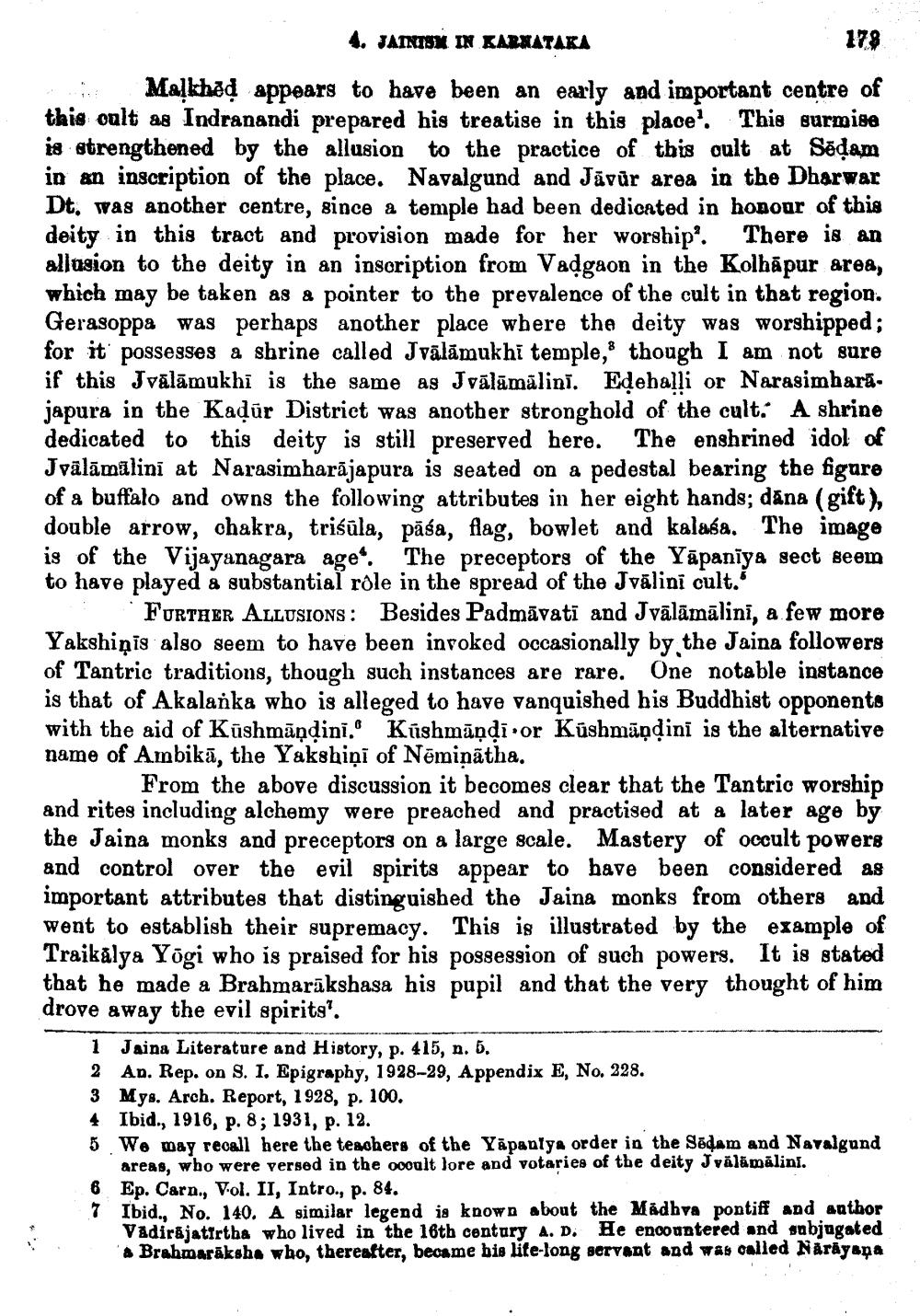________________
4. JAINISM IN KARNATAKA
178
Malkhod appears to have been an early and important centre of this oult as Indranandi prepared his treatise in this place. This surmise is strengthened by the allusion to the practice of this cult at Sadam in an inscription of the place. Navalgund and Jāvur area in the Dharwar Dt. was another centre, since a temple had been dedicated in honour of this deity in this tract and provision made for her worship'. There is an allusion to the deity in an inscription from Vadgaon in the Kolhāpur area, which may be taken as a pointer to the prevalence of the cult in that region. Gerasoppa was perhaps another place where the deity was worshipped ; for it possesses a shrine called Jvālāmukhi temple, though I am not sure if this Jvālāmukhi is the same as Jvālāmālinā. Edeballi or Narasimharā. japura in the Kadūr District was another stronghold of the cult. A shrine dedicated to this deity is still preserved here. The enshrined idol of Jvālāmalini at Narasimharājapura is seated on a pedestal bearing the figure of a buffalo and owns the following attributes in her eight hands; dana (gift), double arrow, chakra, triśūla, pāśa, flag, bowlet and kalasa. The image is of the Vijayanagara age. The preceptors of the Yāpaniya sect seem to have played a substantial role in the spread of the Jvālini cult.
* FURTHER ALLUSIONS: Besides Padmāvati and Jvālāmālini, a few more Yakshiņis also seem to have been invoked occasionally by the Jaina followers of Tantric traditions, though such instances are rare. One notable instance is that of Akalanka who is alleged to have vanquished his Buddhist opponents with the aid of Kushmāņdini. Kushmāņdi.or Kushmāņdini is the alternative name of Ambikā, the Yakshiņi of Nēminātha.
From the above discussion it becomes clear that the Tantric worship and rites including alchemy were preached and practised at a later age by the Jaina monks and preceptors on a large scale. Mastery of occult powers and control over the evil spirits appear to have been considered as important attributes that distinguished the Jaina monks from others and went to establish their supremacy. This is illustrated by the example of Traikālya Yogi who is praised for his possession of such powers. It is stated that he made a Brahmarākshasa his pupil and that the very thought of him drove away the evil spirits'.
1 Jaina Literature and History, p. 415, n. 5. 2 An. Rep. on S. 1. Epigraphy, 1928-29, Appendix E, No. 228. 3 Mys. Arch. Report, 1928, p. 100. 4 Ibid., 1916, p. 8; 1931, p. 12. 5 Wo may recall here the teachers of the Yāpaniya order in the Sadam and Navalgund
areas, who were versed in the oooult lore and votaries of the deity Jvälāmālini. 6 Ep. Carn., Vol. II, Intro., p. 84. 7 Ibid., No. 140. A similar legend is known about the Madhva pontiff and author
Vadirajatirtha who lived in the 16th century A. D. He encountered and subjugated 'Brahmarāksha who, thereafter, became bis lite-long servant and was called Närayana




